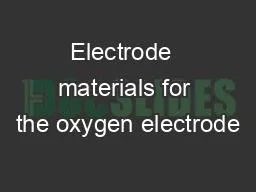

Electrode materials electrocatalysts based on La Ni and Fe for the oxygen evolution reaction OER have been identified and evaluated The electrochemical activity of the materials has been tested at room temperature and pressure conditions in N ID: 794065
Download The PPT/PDF document "Electrode materials for the oxygen elec..." is the property of its rightful owner. Permission is granted to download and print the materials on this web site for personal, non-commercial use only, and to display it on your personal computer provided you do not modify the materials and that you retain all copyright notices contained in the materials. By downloading content from our website, you accept the terms of this agreement.
Slide1
Electrode materials for the oxygen electrodeElectrode materials (electrocatalysts) based on La, Ni and Fe for the oxygen evolution reaction (OER) have been identified and evaluated.The electrochemical activity of the materials has been tested at room temperature and pressure conditions in N2 atmosphere using densely sintered pellets polished down to 1 µm roughness.The chemical stability of the powder , immersed in 45 wt% KOH, and heated in an autoclave to 220°C has been examined comparing XRD patterns before and after.Three-electrode setup for electrochemical characterization Chemical stability assessment
7
BackgroundA HTP-AEC with gas diffusion electrodes (metal foams) and an aqueous KOH electrolyte immobilized in a mesoporous ceramic matrix structure has been developed at DTU Energy.Very high current density and performance has been demonstrated with shirt button sized cells: MotivationHigh temperatures (200°C) increase the activity of the electrodes and the conductivity of the electrolyte significantly. A cell that allows for high efficiency and current density simultaneously using non-noble metals.Challenges Corrosion issues at the oxygen electrode. Identification of more stable materials, which also show sufficiently high catalytic activity towards the oxygen evolution reaction.Processing of cell layers with optimized microstructure using a low cost & scalable processing method. methods.
Introduction
Development of novel High Temperature and Pressure Alkaline Electrolysis Cells (HTP-AEC)
Department of Energy Conversion and StorageRisø CampusFrederiksborgvej 399, 4000 Roskilde
Manchet 48/ 60, 1. niveauManchet 35/45, 2 niveauMellemrubrik 35/45, 3.niveauBrødtekst 35/45, 4 .niveauMellemrubtik 18/24, 5.niveauBrødtekst 18/24, 6. niveau
References[1] C. Chatzichristodoulou, F. Allebrod, M. B. Mogensen, J. Electrochem. Soc., 163 (1) (F3036-F3040), 2016[2] C. C. L. McCrory, S. Jung, J. C. Peters, T. F. Jaramilllo, J. Am. Chem. Soc. 135 (16977-16987), 2013[3] L. Trotochaud, J. K. Ranney, K. N. Williams, S. W. Boettcher, J. Am. Chem Soc. 134 (17253-17261), 2012[4] A. Grimaud, K. J. May, C. E. Carlton, Y-L. Lee, M. Risch, W. T. Hong, J. Zhou, Y. Shao-Horn, Nat. Commun. 4 (2439-2445), 2013
Jens Q Adolphsen (jenqui@dtu.dk); Vanesa Gil, Bhaskar R. Sudireddy and Christodoulos Chatzichristodoulou (ccha@dtu.dk)
[1]
The mesoporous
electrolyte matrix contains the KOH electrolyte. The porous electrodes will allow some infiltration of the electrolyte into the electrode to increase the surface area where the electrochemical reactions take place.
Mesoporous electrolyte matrix
Material
b (V/
dec
)
a
R2η (V) @ 10 mA/cm2LaNiO3 0.0830.300.970.38La0.97NiO30.0920.340.970.44LaNi0.6Fe0.4O30.130.310.950.44LaNi0.6Fe0.4O30.110.330.970.45La2Ni0.9Fe0.1O40.0790.320.980.40IrOx [2]---0.32Ni0.9Fe0.1Ox [3]0.030--0.34PrBaCo2O5+x [4]~0.07--~0.38
The calculated Tafel fit parameters (E = a +b log[i]) from the tafel plot together with the overpotential, η, at 10 mA/cm2. The state-of-the-art, IrOx, and two of the best performing non-noble oxygen evolution catalysts are also included as benchmarking.
The cell concept
Results – chemical stability
Record data from earlier work [1]:3.75 A/cm2 at 1.75 V withηel = 85 % (200°C, 20 bar) [1]
XRD patterns of the as-received LaNiO3 powder and the same powder after exposure to 45 wt% KOH at 220 °C for 1 week. The symbols represent the following phases: ○LaNiO3, ♦ LaO(OH), □ NiO(OH), + La2O3, * NiO. The LaNi0.6Fe0.4O3 and La2Ni0.9Fe0.1O4 powder showed similar decomposition behaviour though at a slower rate.
[1]
Results - Electrochemical activity towards the OER
Reference
electrode (RHE from
G
askatel
)
Working
electrode
(pressed bars,
Au
current collector
)
Counter electrode (Pt mesh)
Separator
The
tafel
plot of
the measurements. The fit is from 0.5 – 10 mA/cm
2
. There is a slight increase in the
tafel
slope above 2 mA/cm
2
which is then not accounted for.
The experiments
Processing of porous oxygen electrodesBased on the electrochemical screening LaNi0.6Fe0.4O3 is going to be used as oxygen evolution electrocatalyst. The microstructure of the oxygen electrode is going to be optimized using the processing method screen printing. An electrode with a bimodal porosity distribution is envisioned to allow for electrolyte infiltration (~10-100 µm pore sizes) and gas diffusion (2-10 µm pore sizes) of evolved oxygen. Successful fabrication and electrochemical characterization of up-scaled cells (5 x 5 cm2) with the microstructurally optimized oxygen electrode is the expected outcome of the project.
The iR-corrected chronopotentiostatic measurements of LaNi0.6Fe0.4 O3 and the Nyquist plot of the EIS measurements performed after each chronopotentiostatic measurement. Current densities are based on geometric surface areas.
ICP analysis of supernatants from the KOH solution used for the chemical stability testing. If any dissolution is happening the ions seem to be consumed by the decomposed products.
LaNi
0.6Fe0.4O3 pellet surface before and after ~20 h electrochemical testing.
Comparisson
of the 2nd set of chronopotentiostatic tests performed at 10 mA/cm2. LaNiO3 could not be sintered dense without decomposition so it is a multiphase of mainly LaNiO3, NiO and La2NiO4
Outlook
Initial polished surface
Polished surface after electrochemical testing